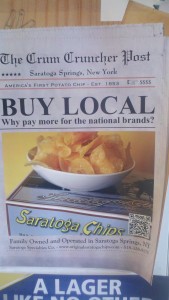A local company is marketing a boutique potato chip in Saratoga Springs, NY, where that salty snack was invented in 1853. The chips are made with high quality potatoes and taste delicious. They are charmingly packaged in a replica of the “takeaway” box from the 1870s. The company is well regarded and family owned. And as a bonus, they are one of the largest clients of Saratoga Bridges, a not-for-profit that finds meaningful work for mentally disabled adults.
Okay, copywriters. Think you can create some kind of a marketing campaign from that?
Oh, there’s one thing I haven’t mentioned. For whatever reason, Saratoga Chips has chosen to sell at a per-ounce price about the same as Lays. I’m not in love with that decision because price competition is the mark of a commoditized product and this is anything but. In fact, there’s a huge potential audience of tourists who come for the track, the spa and the waters who would love to take something back to friends and family in Jersey or Florida.

Unfortunately, the marketing department of Saratoga Chips is not you nor I. Avoiding history, warmth and local color, their copywriter came up with the Walmart-style headline: “Buy local… why pay more for the national brands?” Doing the copywriter one better, the art director mistrusted the visual appeal of the product and the antique box and subjugated them to a fake newspaper page (“Crum Cruncher” refers to George Crum, the inventor of the chip, but of course the reader doesn’t know this) superimposed on a fake wood background as if, I guess, the fake newspaper has been plopped down on a fake table.
Purely on the basis of missed opportunity, Saratoga Chips is hereby fast-tracked into the Badvertising Hall of Shame.